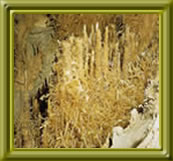The kinds of habitat one can find in the cave are five: Bat excrement hills. Alistrati cave is one of the few Greek caves which has so big quantities (tons) of bat excrement. This fact shows how important this cave was for the bat's spending their day-time and winter-time.
 |
Excrement hills, in various decay degrees are spread all over the cave.
The biggest quantities are in the guano chambers. In no other hill, so
rich in population and species have guano bio-societies been observed.
Crowds of Coleoptera, Diplopoda, spiders all of which are troglofila,
live there. Especially these hills are of particular significance for
the eco-system.
The rest of the hills are either in extended decay degree or have been
stepped upon all over by the visitors.
Small areas with bat excrement.
All over the cave there is a plethora of small guano "spots",
however more and undisturbed quantities lie beyond the passage which the
visitors follow.
Here societies are simpler, poorer in diversity and populations.
Yet, these "spots" are very important, due to their big number
and because there, the two troglovia isopoda are fed (since the "spots"
lack the many antagonists and predators)
Organic matter- flora.
Actually, this is a food-area and not a habitat.
And that's the wood, leaves and seeds that have fallen (entrance) or carried
(by animals or the man) into the cave.
They are mentioned separately because they are food for trogloria isopoda
and chilopoda
Lias soil. It
is the micro-environment with the least food in the cave and in a relatively
good condition is found in the chambers on the right and on the left of
the artificial entrance.
Since the organic matter of predatory coleoptera and spiders is very limited
and possibly because of that, only here the presence of the very significant
trolovion dipluron is noticeable
Walls. In the nock walls, up to 1m high in average, spiders diplopoda and diplura live